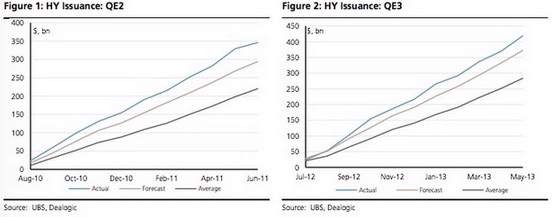“What’s even more dangerous than the actual stock market is the high yield market,†Carl Icahn (who is perhaps talking his book) recently warned, before saying he “feels sorry†for all of those throwing their money into junk bonds in a desperate search for yield. We have of course long warned that a half decade of easy money policies have had the unfortunate side effect of allowing otherwise insolvent companies (most notably energy producers) to stay afloat by keeping rates artificially low, thus creating demand for HY debt while simultaneously ensuring that borrowing costs for issuers remain (very) favorable. Indeed, HY issuance is quite clearly correlated with successive rounds of QE as the following charts show:

More specifically, UBS notes that “the picture is crystal clear: In both periods, issuance was $130bn more than average, or about 50% greater than the average amount expected, over an 11 month period. The main drivers were lower yields, sharp drops in yields (we find that the speed of yield changes plays a significant role in impacting issuance), and strong inflows.â€
Over time, this has had the effect of, in Citi’s words, destroying creative destruction by creating a legion of zombie companies which have continued to produce when they likely should have been long buried, contributing to a global supply glut and ultimately, to deflation.
Unfortunately, this dynamic will persist as long as the Fed keeps rates suppressed, as investors have virtually no alternative but to look for yield wherever they can find it, especially when many risk-free assets have a negative carry. It’s no surprise then that Bloomberg is out calling junk bonds “the new haven assetâ€:
The new fixed-income haven is, of all things, the market for junk bonds.
With government bonds in Germany to Japan yielding less than nothing, money is pouring into exchange-traded funds that buy speculative-grade debt, traditionally the riskiest of fixed-income assets.
The pace is staggering. So far this year, about $9 billion has flowed into the funds globally, a significant chunk for the $44.4 billion market in junk-debt ETFs.
In the land of negative yields, even the most conservative firms such as Zurich Insurance Group AG and Assicurazioni Generali SpA, the biggest Swiss and Italian insurers, are planning to invest in sub-investment grade debt for the first time. One of the bond market’s brightest luminaries, Jeffrey Gundlach, says you’re better off in junk because the only money to be made on German bunds is from betting against them.
While last week’s sudden selloff in euro sovereign debt gives investors all the more reason to crowd into high-yield assets, the lingering concern is that buyers are exposing themselves to even greater losses. And with the European Central Bank’s bond purchases still keeping government yields close to historic lows, many bond investors have few other options.
“Investors are being forced by the central bank to assume more risk,â€Â Jens Vanbrabant, a money manager at ECM Asset Management, which oversees $6.5 billion, said from London. “They’re trying to adapt their investment parameters to the new situation of zero or negative yields.â€

